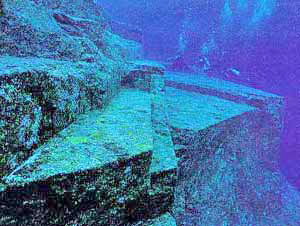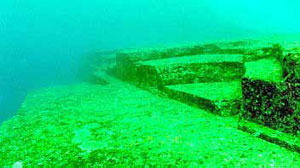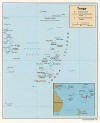|

by Frank Joseph
Frank Joseph is editor of
The Ancient American Magazine
In March 1995, a sport diver unintentionally strayed beyond the
standard safety perimeter near the south shore of Okinawa.
A battleground for the last land campaign of World War II, the
island was about to become the scene of another kind of drama. As he
glided through unvisited depths some forty feet beneath the clear
blue Pacific, the diver was suddenly confronted by what appeared to
be a great stone building heavily encrusted with coral.
Approaching closer, he could see that the colossal structure
was black and gaunt, a sunken arrangement of monolithic blocks, their
original configuration obscured by the organic accretion of time.
After encircling the anonymous monument several times and taking
several photographs of it, he rose to the surface, reoriented
himself and kicked for shore. Next day, photographs of his find
appeared in Japan's largest newspapers. The structure sparked
instant controversy and attracted crowds of diving archaeologists,
news media people and curious nonprofessionals, none of whom were
able to ascertain its identity. They could not even agree if it was
manmade, let alone ancient or modern. Was it the remnant of some
forgotten military coastal defense from the war? Or could it
possibly date back to something entirely different and profoundly
older?
Already there were whispers of the lost culture of Mu,
preserved in legend as the Motherland of Civilization,
which perished in the sea long before the beginning of recorded
time. But Okinawa's drowned enigma was hermetically locked within
too thick an encrustation. The structure looked anciently manmade.
Nature, however, sometimes made her own forms appear artificial.
Popular and scientific debate concerning its origins argued back and
forth. Then, in late summer of the following year, another diver in
Okinawa waters was shocked to see a massive arch or gateway of huge
stone blocks beautifully fitted together in the manner of
prehistoric masonry found among the Inca cities on the other side of
the Pacific Ocean, in the Andes Mountains of South America.
 This time there was no
doubt. Thanks to swift currents in the area, coral had been unable
to gain any foothold on the structure, leaving it unobscured in the
100-foot visibility of the crystal-clear waters. It was certainly
manmade and very old. It seemed nothing short of miraculous, an
unbelievable vision standing in apparently unruined condition on the
ocean floor. This time there was no
doubt. Thanks to swift currents in the area, coral had been unable
to gain any foothold on the structure, leaving it unobscured in the
100-foot visibility of the crystal-clear waters. It was certainly
manmade and very old. It seemed nothing short of miraculous, an
unbelievable vision standing in apparently unruined condition on the
ocean floor.
But its discovery was only
the first of that summer's undersea revelations. Now fired by the
possibility of more sunken structures in the area, teams of expert
divers fanned out from the south coast of Okinawa using standard
grid-search patterns.
Their professional efforts
were soon rewarded. Before the onset of autumn, they found five sub
surface archaeological sites near three offshore islands.
The locations vary at depths from 100 to only 20 feet,
but are all stylistically linked, despite the great variety of their
architectural details. They comprise paved streets and crossroads,
huge altar-like formations, grand staircases leading to broad plazas
and processional ways surmounted by pairs of towering features
resembling pylons. The sunken buildings are known to cover the ocean
bottom (although not continuously) from the small island of
Yonaguni in the southwest to Okinawa and its neighboring
islands, Kerama and Aguni, some 311 miles. If, after
all, ongoing exploration here does indeed reveal more structures
linking Yonaguni with Okinawa, the
individual sites may be separate components of a huge city lying at
the bottom of the Pacific.
 The single largest
structure so far discovered lies near the eastern shore of
Yonaguni at 100 feet down. It is approximately 240
feet long, 90 feet across and 45 feet high. The single largest
structure so far discovered lies near the eastern shore of
Yonaguni at 100 feet down. It is approximately 240
feet long, 90 feet across and 45 feet high.
All the monuments appear
to have been built from a granitic sandstone, although
no internal passages or chambers have been found.
To a degree, the
underwater structures resemble ancient buildings on Okinawa itself,
such as Nakagusuku Castle.
More of a ceremonial
edifice than a military installation, Nakagusuku dates back
to the early centuries of the first millennium B.C., although its
identity as a religious habitation site is older still. Its builders
and the culture it originally expressed are unknown, although the
precinct is still regarded with a superstitious awe by local
Okinawans.
 Other parallels with
Okinawa's oldest sacred buildings are found near Noro,
where burial vaults designed in the same rectilinear style are still
venerated as repositories for the islanders' ancestral dead. Other parallels with
Okinawa's oldest sacred buildings are found near Noro,
where burial vaults designed in the same rectilinear style are still
venerated as repositories for the islanders' ancestral dead.
Very remarkably, the
Okinawan term for these vaults is moai, the
same word Polynesians of Easter Island, more than
6,000 miles away, used to describe the famous, large-headed,
long-eared statues dedicated to their ancestors!
Possible connections far
across the Pacific may be more than philological. Some of the sunken
features bear even closer comparison to heiau found in
the distant Hawaiian Islands. These are linear temples of long stone
ramparts leading to great staircases surmounted by broad plazas,
where wooden shrines and carved idols were placed. Many heiau
still exist and continue to be venerated by native Hawaiians. In terms
of construction, the Okinawan examples comprise enormous, single
blocks, while the heiau are made up of far more
numerous, smaller stones. They were first built, according to
Hawaiian tradition, by the Menehune, a red-haired
race of master masons who occupied the islands long before the
arrival of the Polynesians. The original inhabitants left, unwilling
to intermarry with the newcomers.
Okinawa's drowned structures find possible counterparts at the eastern
limits of the Pacific Ocean, along Peruvian coasts. The most
striking similarities occur at ancient Pachacamac,
a sprawling religious city a few miles south of the modern capital
at Lima. Although functioning into Inca times, as late as the
sixteenth century, it pre-dated the Incas by at least 1,500 years
and was the seat of South America's foremost oracle. Pilgrims
visited
Pachacamac from all over the Tiawantisuyu, the Inca
Empire, until it was sacked and desecrated by the Spaniards under
Francisco Pizarro's high-spirited brother, Hernando, with
22 heavily armed conquistadors. Enough of the sun-dried, mud-brick
city remains, with its sweeping staircases and broad plazas, to
suggest parallels with the sunken buildings around Okinawa.
Two other pre-Inca sites in the north, just outside Trujillo, likewise
share some leading elements in common with the overseas, undersea
structures. The so-called Temple of the Sun is a
terraced pyramid built 2,000 years ago by a people known as the
Moche. More than 100 feet high and 684 feet long, the
irregularly stepped platform of unfired adobe bricks was formerly
the colossal centerpiece of a city sheltering 30,000 inhabitants.
Its resemblance to the structure found at Yonaguni is
remarkable.
On the other side of the Pacific, the first emperor of Japan
was remembered as Jimmu, whose immediate descendant was
Kamu, among the legendary founders of Japanese society.
Another ancestral emperor was Temmu, who was said to
have committed to memory the Kojiki (Records of
Ancient Matters) and the Nihongi (Chronicles of
Japan). In northern Japan runs a river deemed sacred because it
carried the first semi-divine beings into the country; it is called
the Mu River. In Japanese, the word mu means,
that which does not exist or no longer exists, just as it does in
Korean. Does it harkens back to a land that no longer exists?
In ancient Rome, the Lemuria was a ritual
conduced by the head of each household to properly appease the
spirits of the deceased, who returned annually. Lemuria
was also the Roman name for a huge island kingdom they believed once
lay in the Far Eastern Sea, sometimes imagined to have been the
Indian Ocean. It vanished to become the abode of troubled souls.
The Lemurian
ceremony was instituted by Romulus in expiation for the murder of
Remus. Here, too, we encounter Mu in relation to
the founding of a civilization, since the brothers were accepted as
the progenitors of Rome. In Latin, their names are pronounced with
the accent on the second syllable: RoMUlus and ReMUs.
In the early nineteenth century, when English biologists were in the
process of mammal classification, they applied the ancient term,
lemur, to describe primitive tree primates first found in
Madagascar, because the creatures possessed large, glaring eyes,
just like the ghostly lemures described in Roman myth. When
lemurs were discovered outside Africa, in such widely separated
locations as south India and Malaya, scientists theorized that a
continent in the Indian Ocean may have once connected all these
lands before it sank beneath the waves. Oceanographers have since
established that no such continent ever existed.
But collectors of oral traditions throughout the island peoples of the
Pacific were perplexed by recurring themes of a vanished
motherland
from which ancestral culture-bearers arrived to re-plant society's
seeds. On Kaua'i, the Hawaiians told of the Mu
(also known as the Menehune mentioned earlier) who
arrived in the dim past from a floating island. The most important
ancestral chant known to the Hawaiians was the Kumulipo,
which recounts a terrific flood that destroyed the world long ago.
Its concluding lines evoke some natural catastrophe in the deep
past:
Born the roaring,
advancing and receding of waves, the rumbling sound, the earthquake.
The sea rages, rises over the beach, rises to the inhabited places,
rises gradually up over the land. Ended is the line of the first
chief of the dim past dwelling in cold uplands. Dead is the current
sweeping in from the navel of the earth. That was a warrior wave.
Many who came vanished, lost in the passing night. The survivor who
escaped the warrior wave was Kuamu.
Despite an abundance of
folk traditions spanning the Pacific, all describing a sunken
homeland, the first accurate, sonar-generated maps of the ocean
bottom revealed nothing resembling a lost continent. But
archaeological enigmas supporting the myths still exist at such
remote locations as tiny Malden Island, where a road
of paved stones leads directly into and under the sea. The
uninhabited island is also home to forty platform-pyramids.
A provocative architectural theme linking South America to Japan
through Polynesia and suggesting a lost intermediary culture is the
sacred gate. The aesthetic focus of Tiahuanaco
(see our Section "Tiahuanaco"),
a great ceremonial city high in Bolivia's Andes near Lake Titicaca,
is two ritual gates. One above the sunken court at the entrance
dramatically frames the 12-foot-tall statue of a god or man, while
the other, at the far end of the complex, is the famous Gateway of
the Sun, oriented to various solar phenomena.
 Out across the Pacific, in
the Polynesian island of Tonga, stands the
Haamonga-a-Maui, The Burden of Maui, a
15-foot-high stone gate weighing some 109 tons and aligned with
sunrise of the summer solstice. Japan is covered by many thousands
of such gates, most of them wooden, but all used to define a sacred
space.
("click" on
photos to enlarge). Out across the Pacific, in
the Polynesian island of Tonga, stands the
Haamonga-a-Maui, The Burden of Maui, a
15-foot-high stone gate weighing some 109 tons and aligned with
sunrise of the summer solstice. Japan is covered by many thousands
of such gates, most of them wooden, but all used to define a sacred
space.
("click" on
photos to enlarge).
 Known as Torii,
the same word appears in ancient Indo-European languages and
survives in the German word for gate: Tor. Known as Torii,
the same word appears in ancient Indo-European languages and
survives in the German word for gate: Tor.
An outstanding feature of
the sunken structures in the vicinity of Okinawa is an unconnected
gate of massive stonework. The Romans, who celebrated a Lemuria
festival every May, ornamented their empire with
free-standing ceremonial gates.
These intriguing parallels, combined with a wealth of archaeological
evidence and descriptive native traditions, convince investigators
that some powerful, centrally located X-culture indeed
existed in the Pacific, from which civilizing influences spread in
both directions. Their conclusion seemed borne out with recent
discoveries among the Ryukyu Islands, where
architectural features of the sunken structures bear tell-tale
affinities to pre-Inca structures in Peru and ancestral burial
vaults on Okinawa. But the sunken buildings provoke more questions
than they answer. How old are they? Why are they under water? Who
built them? For what purposes?
What evidence has so far been collected suggests that the site did not
succumb to a sudden geologic catastrophe. Aside from one or two
monuments leaning at irregular angles, none of them displays any
structural damage, no cracks or fallen stones. Instead, they
appear in unruined, virtually pristine condition. They were
either overwhelmed by rising sea-levels, sank with a slowly
collapsing land-mass, or some combination of both. Most researchers
opt for the last scenario, since oceanographers tell us that
sea-levels rose from 100 feet 1.7 million years ago. Even so, the
Japanese sites must be very old. They are constantly being swept
clean by strong currents, so radiocarbon dating material is not
available.
 The purposes for which
they were made appear less difficult to understand, because their
strongest resemblance to Hawaiian heiau
implies that they were mostly ceremonial in nature. Their
expansive staircases lead up to presently barren platforms, where
wooden shrines and carved idols were probably set up for religious
dramas. The purposes for which
they were made appear less difficult to understand, because their
strongest resemblance to Hawaiian heiau
implies that they were mostly ceremonial in nature. Their
expansive staircases lead up to presently barren platforms, where
wooden shrines and carved idols were probably set up for religious
dramas.
Just who were their
worshippers and builders suggests a word most professional American
archaeologists are unable to pronounce. But, in view of the numerous
accounts from hundreds of cultures around the Pacific of a flood
that destroyed some former civilization, if Okinawa's sunken city is
not lost Lemuria, then what is it?
|
 This time there was no
doubt. Thanks to swift currents in the area, coral had been unable
to gain any foothold on the structure, leaving it unobscured in the
100-foot visibility of the crystal-clear waters. It was certainly
manmade and very old. It seemed nothing short of miraculous, an
unbelievable vision standing in apparently unruined condition on the
ocean floor.
This time there was no
doubt. Thanks to swift currents in the area, coral had been unable
to gain any foothold on the structure, leaving it unobscured in the
100-foot visibility of the crystal-clear waters. It was certainly
manmade and very old. It seemed nothing short of miraculous, an
unbelievable vision standing in apparently unruined condition on the
ocean floor.  The single largest
structure so far discovered lies near the eastern shore of
Yonaguni at 100 feet down. It is approximately 240
feet long, 90 feet across and 45 feet high.
The single largest
structure so far discovered lies near the eastern shore of
Yonaguni at 100 feet down. It is approximately 240
feet long, 90 feet across and 45 feet high.  Other parallels with
Okinawa's oldest sacred buildings are found near Noro,
where burial vaults designed in the same rectilinear style are still
venerated as repositories for the islanders' ancestral dead.
Other parallels with
Okinawa's oldest sacred buildings are found near Noro,
where burial vaults designed in the same rectilinear style are still
venerated as repositories for the islanders' ancestral dead. 

 The purposes for which
they were made appear less difficult to understand, because their
strongest resemblance to Hawaiian heiau
implies that they were mostly ceremonial in nature. Their
expansive staircases lead up to presently barren platforms, where
wooden shrines and carved idols were probably set up for religious
dramas.
The purposes for which
they were made appear less difficult to understand, because their
strongest resemblance to Hawaiian heiau
implies that they were mostly ceremonial in nature. Their
expansive staircases lead up to presently barren platforms, where
wooden shrines and carved idols were probably set up for religious
dramas.